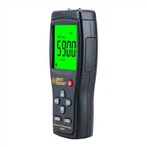The method and steps of judging the motor speed with a multimeter
Ordinary three-phase squirrel cage motors have two speeds: one is the synchronous speed N1, the so-called synchronous speed is the speed of the rotating magnetic field of the motor, this speed has a strict relationship with the number of pole pairs of the motor, that is, n1=60f/p
Among them, n1——synchronous speed, rev/min;
J——the frequency of the current, the number of cycles/second;
P - the number of pole pairs of the motor.
The second is the asynchronous speed, that is, the speed of the motor shaft. When the motor drives the production machinery, the motor shaft rotates at a slightly lower speed than the rotating magnetic field, but the difference is almost the same. For example, for a pair of magnetic pole motors, the rotating speed of the motor wheel is 2950 rpm, 1430 rpm for a two-pole motor, and 920 rpm for a three-pole motor. According to the above principle, the multimeter can be used to judge the number of magnetic poles of the motor, and then determine the speed of the motor;
Steps to use a multimeter to judge the number of pole pairs of a motor
1. Fold off the six wire ends of the motor;
2. Use the ohm block of the multimeter to find any phase of the three-phase winding, as shown in the figure 1~2;
3. Turn the milliampere gear of the multimeter to the smallest gear, and connect its two wires to terminals l~2;
4. Turn the motor shaft slowly, and observe the change of the pointer of the multimeter. If the rotating shaft rotates one circle and the pointer swings once, it means that the current changes for one cycle, and it is a pair of magnetic poles; if it swings twice, it is two pairs of magnetic poles; if it swings three times, it is three pairs of magnetic poles.






